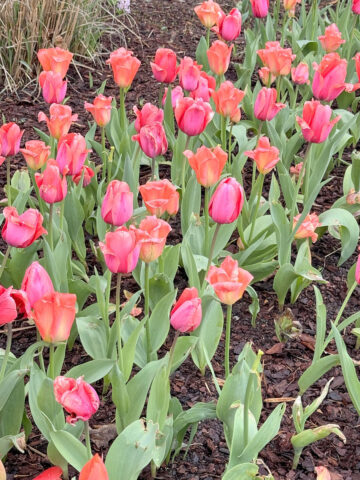Written by Christie Crawford
 Clarksville, TN – Roses are red, violets are blue…as goes the nursery rhyme. But what about roses are love, violets are modesty? If you’re a follower of floriography, which is the science of using flowers to convey messages, then this would be your take on the popular poem.
Clarksville, TN – Roses are red, violets are blue…as goes the nursery rhyme. But what about roses are love, violets are modesty? If you’re a follower of floriography, which is the science of using flowers to convey messages, then this would be your take on the popular poem.
Floriography, the language of flowers, is centuries old and crosses most cultures. The most intense practice of using flower messages was the selam, a custom in Turkey for harem members, who could not read or write, but could communicate with each other by exchanging flowers. Certain flowers were associated with particular meanings and rhymes.

This ritual was made extremely popular in the Victorian era when British aristocrat Lady Mary Wortley Montagu, who resided in Constantinople as the ambassador’s wife, wrote to her English friends about the custom. Floriography became a norm during this time period, where the color, scent, and blooms of a particular flower had significant meaning.
This coincided with a growing interest in the field of botany, especially among upper-class women. As you recall, society was repressed at this time so the use of flowers in nosegays or bouquets became a way to express individuality when society would not allow such feelings.
An example of floral color would be the use of red as a way to express love, pink as motherly love, white as good luck, and yellow as disappointment. Even how you accepted flowers had significance. If you placed flowers in your right hand, it meant “yes” and in your left, meant “no” while holding a floral posy upside down conveyed the strongest form of rejection. If corsages were worn, the placement of flowers was important. Flowers held in the center indicated friendship while over the heart meant true love.

In France, Le Language des Fleurs was published in 1819 by Madame Charlotte de la Tour, which was the first dictionary of floriography. Many others soon followed, including famous illustrator Kate Greenaway’s The Language of Flowers, which is still in print today. Artists also took note, including William Shakespeare, where in Hamlet, Ophelia holds a bouquet of rosemary, pansies, fennel, rue, columbines, and daisies, which convey many connotations including memory, innocence, and folly.
In Jane Eyre, the main character sees crocuses, which indicate youth and gladness, and snowdrops, indicating that hope is emerging. Painter John Singer Sargent included the prominence of flowers in his Carnation, Lily, Lily, Rose masterpiece, while Dante Gabriel Rossetti’s work also featured the dominance of flowers.
Flowers as religious symbols still play an important role today. In Christianity, the use of lilies indicates the purity and chastity of saints, while the red or white rose is depicted as a symbol of the Virgin Mary. Buddhism views the lotus as an icon of enrichment and rebirth while the marigold flower in Hinduism represents love. In ancient Greece and Rome, gods and goddesses often turned themselves into flowers, or had others change them into a particular bloom.

In Eastern cultures, peonies were depicted as signs of fame and fortune, while chrysanthemums represented long life. In Japan, the practice of hanakotoba, which is the Japanese version of floriography, arose during the Meiji Period (1868-1912), similar to the Victorian heyday. You may recognize this today through the art of floral arranging called ikebana, which literally translates to giving life to flowers and even can be found in Japanese comics (manga) or animation (anime).
Flowers still remain important symbols at present, and it’s very common to see countries, regions, and states with official flowers. For example, Tennessee’s state flower is the Iris, which means good tidings and has a Greek origin as Iris was the Goddess of the rainbow. She was a messenger to the gods both mentioned in The Iliad as well as in the Roman poet Virgil’s work. Irises were also an emblem of pre-revolutionary France, such as the fleur de lis, named after King Louis VII, who won a battle in a field of yellow irises.
Renewed interest in the language of flowers continues today. In 2012, Vanessa Diffenbaugh wrote the New York Times fictional bestseller The Language of Flowers, where I first read about the subject. In 2020 Nashville illustrator Jessica Roux wrote Florigraphy, in 2022 The Complete Language of Flowers was printed, and in 2023 Flowers and Their Meanings was published.
To help you demystify some of your common flora, I’ll share 5 common flowers and their meanings:
- Tulip – if red, a declaration of love, yellow, a hopeless love, pink, a sign of affection or care, white, a symbol of forgiveness and respect, and purple, a representation of elegance.
- Carnation – if red, a sign of passion, white , a symbol of talent, variegated, an indication of refusal, and yellow, a depiction of disdain.
- Daisy – a signal for innocence.
- Lilac – if white, an expression of innocence and purple, a proclamation of first love.
- Gladiola – a suggestion of provocation.
So, this spring as you plant your flower beds or choose a bouquet for a favorite someone, just remember that years ago flowers spoke louder than words. Hence, the popular phrase “Say it with flowers.”



